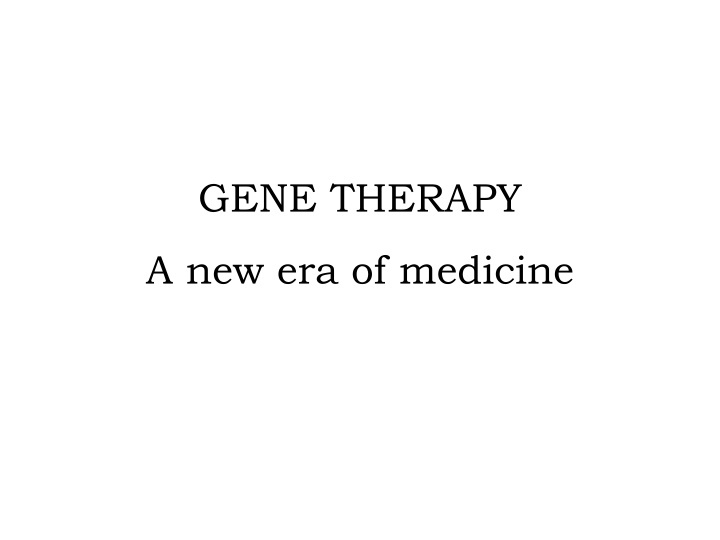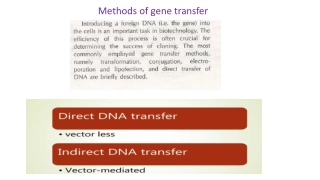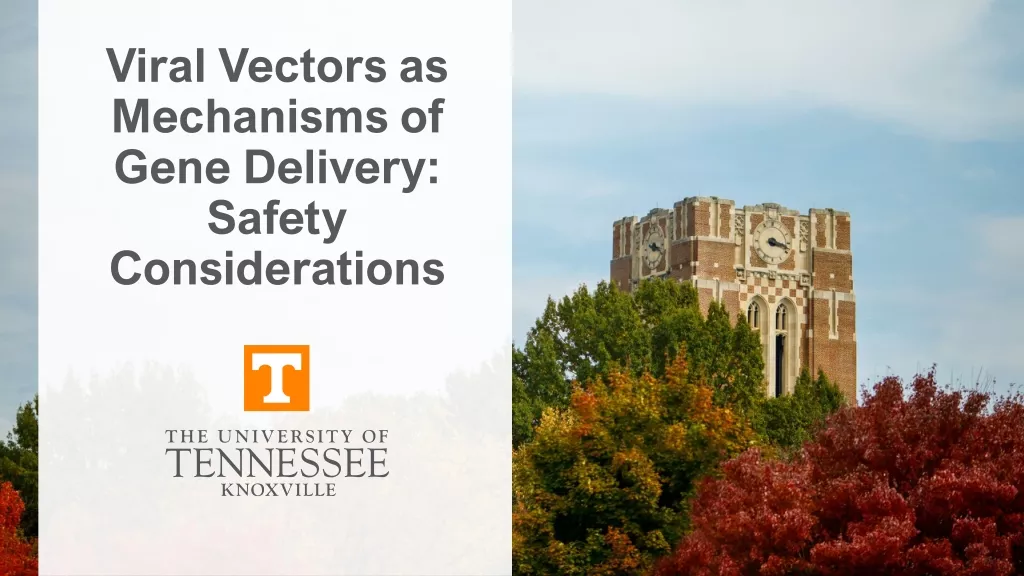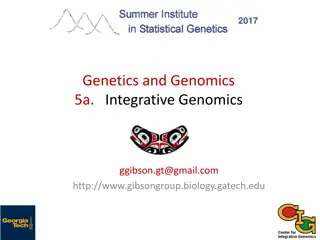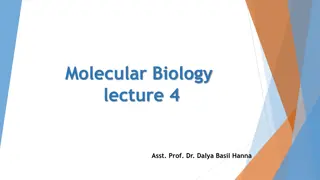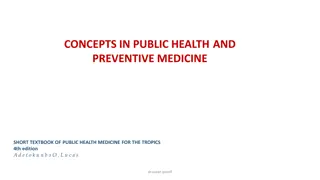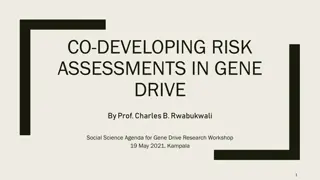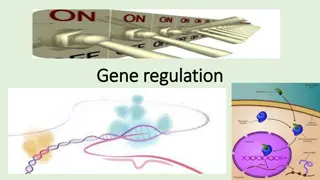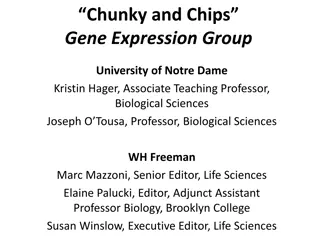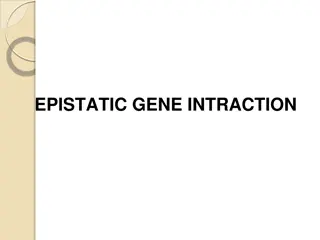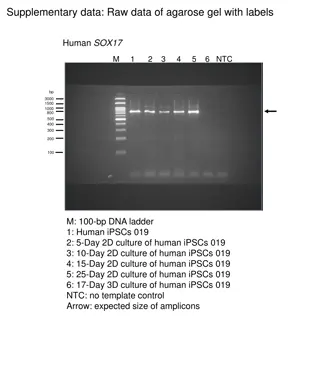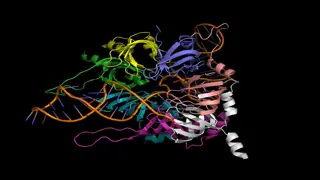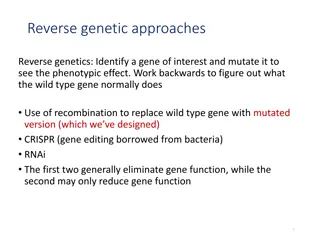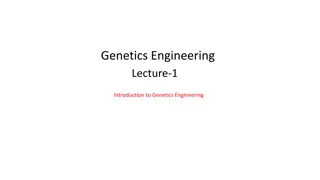Exploring Therapy and Gene Therapy in Modern Medicine
Gene therapy represents a new era of medicine aimed at correcting genetic disorders. Meanwhile, therapy in its various forms, such as plant-based therapy and antibiotic treatment, addresses health issues across different domains. From targeting the genetic makeup to utilizing antibiotics against bacterial infections, advancements in medicine continue to redefine treatment approaches in both traditional and innovative ways.
Download Presentation

Please find below an Image/Link to download the presentation.
The content on the website is provided AS IS for your information and personal use only. It may not be sold, licensed, or shared on other websites without obtaining consent from the author.If you encounter any issues during the download, it is possible that the publisher has removed the file from their server.
You are allowed to download the files provided on this website for personal or commercial use, subject to the condition that they are used lawfully. All files are the property of their respective owners.
The content on the website is provided AS IS for your information and personal use only. It may not be sold, licensed, or shared on other websites without obtaining consent from the author.
E N D
Presentation Transcript
GENE THERAPY A new era of medicine
Therapy Therapy is the attempted remediation of a health problem, usually following a diagnosis. In the medical field, it is usually synonymous with treatment. Among psychologists and other mental health professionals, including psychiatrists, psychiatric nurse practitioners, and clinical social workers, the term may refer specifically to psychotherapy or talking therapy. The English word therapy comes via Latin therap a and literally means "curing" or "healing"
Forms of therapy 1. Plant Based Therapy Doctrine of Signature which assumes that the appearance of the plant gives a clue to its medicinal value. For example, Red juice and sap are used for blood and menstrual associated complications; yellow flowers for jaundice and bile and certain roots, with human shape for female form of fertility.
Examples include 1. Gum of Acacia nilotica (Kikar) is used for the treatment of diarrhea 2. One teaspoonful of gum of Acacia modesta (Palosa), dissolved in a glass of water, called Zhuble sharbat, is used as a health tonic. 3. The dried bark of Rhamnus frangula and dried ripe berries of Rhamnus catharticus are also used for constipation
2. ANTIBIOTICS Agents that are used against life Examples Antibacterial antibiotics are commonly classified based on their mechanism of action, chemical structure, or spectrum of activity. Most target bacterial functions or growth processes. Some target the bacterial cell wall (Penicillins and Cephalosporins) or the cell membrane ( Polymyxins), or interfere with essential bacterial enzymes (Rifamycins inhibits bacterial RNA polymerase
Miconazole is an antifungal agent, developed by Janssen Pharmaceutica Belgium , commonly applied topically to the skin or mucous membrane to cure fungal infections. It works by inhibiting the synthesis of Ergosterol, a critical component of fungal cell membranes Chloroquine is an anti-malarial drug
Gene Therapy Genes are carried on a chromosome and the basic unit of heredity Encode how to make a protein DNA RNA proteins Proteins carry out most of life s function. When there is a mutation in the gene, then it will change the codon, which will change which amino acid is called for, which will change the conformation of the protein, which will change the function of the protein. Genetic disorders result from mutations in the genome.
Gene therapy is the use of DNA as a drug to treat disease by delivering therapeutic DNA into a patient's cells. The most common form of gene therapy involves: using DNA that encodes a functional, therapeutic gene to replace a mutated gene. using DNA that encodes a therapeutic protein drug (rather than a natural human gene) to provide treatment. In gene therapy, DNA that encodes a therapeutic protein is packaged within a Vector", which is used to get the DNA inside cells within the body. Once inside, the DNA becomes expressed by the cell machinery, resulting in the production of therapeutic protein, which in turn treats the patient's disease.
Sickle Cell anemia Is a recessive autosomal disorder humans have hemoglobin A, which consists of two alpha and two beta chains The gene defect is a known mutation of a single nucleotide single (A to T) of the -globin gene, which results in Glutamic acid being substituted by Valine at position 6. Hemoglobin S with this mutation is referred to as HbS, as opposed to the normal adult HbA
The First Case The first gene therapy was performed on September 14th, 1990 Ashanti DeSilva was treated for ADA-SCID Doctors removed her white blood cells, inserted the missing gene into the WBC, and then put them back into her blood stream. This strengthened her immune system Only worked for a few months
ADA SCID Adenosine deaminase deficiency-Severe Combined Immunodeficiency Adenosine deaminase deficiency, also called ADA deficiency or ADA-SCID, is an autosomal recessive disorder that causes immunodeficiency. It occurs in fewer than one in 100,000 live births worldwide. It accounts for about 15% of all cases of severe combined immunodeficiency (SCID). Only 3% of children are born with this gene
Adenosine deaminase Adenosine deaminase is an enzyme involved in Purine metabolism. It is needed for the breakdown of adenosine from food and for the turnover of nucleic acids in tissues. This enzyme is produced in all cells, but the highest levels of adenosine deaminase occur in immune system cells called lymphocytes. Lymphocytes form the immune system, which defends the body against potentially harmful invaders, such as viruses or bacteria.
The function of the adenosine deaminase enzyme is to eliminate a molecule called deoxyadenosine, which is generated when DNA is broken down. Adenosine deaminase converts deoxyadenosine, which is toxic to lymphocytes, to another molecule called deoxy inosine, which is not harmful.
ADA GENE The ADA gene is located on the long (q) arm of chromosome 20 at position 13.12. More precisely, the ADA gene is located from base pair 44,619,518 to base pair 44,651,734 on chromosome 20. [32, 216 bp]. More than 70 mutations in the ADA gene have been identified. Most of these mutations result in the substitution of one amino acid for another amino acid in the adenosine deaminase enzyme. Other mutations cause the enzyme to be unstable or prevent it from being produced at all.
GENETICS ADA deficiency is inherited in an autosomal recessive manner. This means the defective gene responsible for the disorder is located on an autosome (chromosome 20 is an autosome), and two copies of the defective gene (one inherited from each parent) are required in order to be born with the disorder. The parents of an individual with an autosomal recessive disorder both carry one copy of the defective gene, but usually do not experience any signs or symptoms of the disorder.
Although early clinical failures led many to dismiss gene therapy as over-hyped, clinical successes since 2006 have created new optimism in the promise of gene therapy. These include successful treatment of patients with the retinal disease, X-Linked SCID, Haemophilia and Parkinson s disease. These clinical successes have led to a renewed interest in gene therapy, with several articles in scientific and popular publications calling for continued investment in the field.
SUCCESS CASE In 2012, Glybera (trade name) became the first gene therapy treatment to be approved for clinical use in either Europe and United States after its endorsement by the European Commission. Glybera is a gene therapy treatment that compensates for Lipoprotein Lipase deficiency, which can cause severe Pancreatitis. Lipoprotein lipase (LPL) is a member of the Lipase gene family, a water soluble enzyme that hydrolyzes Triglycerides in Lipoproteins, such as those found in Very Low Density Lipoproteins (VLDL), into two free Fatty acids and Monoacylglycerol molecule.
It is also involved in promoting the cellular uptake of chylomicron remnants, cholesterol-rich lipoproteins, and free fatty acids. LPL is most widely distributed in adipose, heart, and skeletal muscle tissue, as well as in lactating mammary glands. Glybera is to cost around $1.6 million for treatment which will make it the most expensive medicine in the world.
TYPES OF GENE THERAPY Gene therapy may be classified into the two following types, only one of which has been used in humans: Somatic gene therapy As the name suggests, in somatic gene therapy, the therapeutic genes are transferred into the somatic cells (non sex-cells), or body, of a patient. Any modifications and effects will be restricted to the individual patient only, and will not be inherited by the patient's offspring or later generations.
Several somatic cell gene transfer experiments are currently in clinical trials with varied success. Over 600 clinical trials utilizing somatic cell therapy are underway in the United States. Most of these trials focus on treating severe genetic disorders, including immunodeficiencies, haemophilia and cystic fibrosis. These disorders are good candidates for somatic cell therapy because they are caused by single gene defects. While somatic cell therapy is promising for treatment, a complete correction of a genetic disorder or the replacement of multiple genes in somatic cells is not yet possible. Only a few of the many clinical tries are in the advanced stages.
Germline gene therapy In germ line gene therapy, germ cells (sperm or eggs) are modified by the introduction of functional genes, which are integrated into their genomes. Germ cells will combine to form a zygote which will divide to produce all the other cells in an organism and therefore if a germ cell is genetically modified then all the cells in the organism will contain the modified gene. This would allow the therapy to be heritable and passed on to later generations.
Although this should, in theory, be highly effective in counteracting genetic disorders and hereditary diseases, some jurisdictions, including Australia, Canada, Germany, Israel, Switzerland, and the Netherlands prohibit this for application in human beings, at least for the present, for technical and ethical reasons, including insufficient knowledge about possible risks to future generations and higher risk than somatic gene therapy. The USA has no federal legislation specifically addressing human germ- line or somatic genetic modification (beyond the usual FDA testing regulations for therapies in general).
VECTORS IN GENE THERAPY Following early advances in genetic engineering of bacteria, cells, and small animals, scientists started considering how this technique could be applied to medicine; could human chromosomes be modified to treat disease? Two main approaches have been considered - adding a gene to replace a gene that wasn't working properly, or disrupting genes that were not working properly. Scientists focused on diseases caused by single-gene defects, such as Hemophilia and Sickle Cell Anemia. As of 2019, gene therapy is still generally an experimental technique, although in 2012, Glybera became the first gene therapy treatment to be approved for clinical use in Europe as a treatment for a disease caused by a defect in a single gene, Lipoprotein Lipase.
In gene therapy, DNA must be administered to the patient, get to the cells that need repair, enter the cell, and express a protein. Generally the DNA is incorporated into an engineered Virus that serves as a Vector, to get the DNA through the bloodstream, into cells, and incorporated into a chromosome. However, so-called Naked DNA approaches have also been explored. Generally, efforts have focused on administering a gene that causes a protein to be expressed, that the patient directly needs.
However, with development of our understanding of the function of nucleases, such as Zinc Finger Nucleases in humans, efforts have begun to incorporate genes encoding nucleases into chromosomes; the expressed nucleases then "edit" the chromosome, disrupting genes causing disease. As of 2014 these approaches have been limited to taking cells from patients, delivering the nuclease gene to the cells, and then administering the transformed cells to patients.
There are other technologies in which nucleic acids are being developed as drugs, such as Antisense RNA, Small interfering RNA and others. To the extent that these technologies do not seek to alter the chromosome, but instead are intended to directly interact with other biomolecules such as RNA, they are generally not considered "gene therapy" per se
VIRUSES All viruses bind to their hosts and introduce their genetic material into the host cell as part of their replication cycle. This genetic material contains basic 'instructions' of how to produce more copies of these viruses, hacking the body's normal production machinery to serve the needs of the virus. The host cell will carry out these instructions and produce additional copies of the virus, leading to more and more cells becoming infected.
Retroviruses The genetic material in retroviruses is in the form of RNA molecules, while the genetic material of their hosts is in the form of DNA. When a retrovirus infects a host cell, it will introduce its RNA together with some enzymes, namely reverse transcriptase and integrase, into the cell. This RNA molecule from the retrovirus produce a DNA copy from its RNA molecule before it can be integrated into the genetic material of the host cell; a process called reverse transcription carried out by reverse transcriptase. After this DNA copy is produced and is free in the nucleus of the host cell, it is incorporated into the genome of the host cell by integrase enzyme.
Advantages and Disadvantages Now that the genetic material of the virus including the desired gene has been inserted, it can be said that the host cell has been modified to contain new genes. If this host cell divides later, its descendants will all contain the new genes. One of the problems of gene therapy using retroviruses is that the integrase enzyme can insert the genetic material of the virus into any arbitrary position in the genome of the host. If genetic material happens to be inserted in the middle of one of the original genes of the host cell, this gene will be disrupted; a phenomenon called insertional mutagenesis. If the gene happens to be one regulating cell division, uncontrolled cell division (i.e., Cancer) can occur. This problem has recently begun to be addressed by utilizing Zinc Finger nucleases to direct the site of integration to specific chromosomal sites.
Gene therapy trials using retroviral vectors to treat X-linked SCID represent one of the most successful application of gene therapy. More than twenty patients have been treated in France and Britain, with a high rate of immune system reconstitution observed. Similar trials were restricted in the USA when Leukemia was reported in patients treated in the French X- SCID gene therapy trial. To date, four children in the French trial and one in the British trial have developed leukemia as a result of insertional mutagenesis by the retroviral vector. All but one of these children responded well to conventional anti-leukemia treatment. Gene therapy trials to treat ADA-SCID continue with relative success in the USA, Britain, Ireland, Italy and Japan.
ADENOVIRUSES Adenoviruses carry their genetic material in the form of double- stranded DNA. They cause respiratory, intestinal, and eye infections in humans (especially the common cold). When these viruses infect a host cell, they introduce their DNA molecule into the host. The genetic material of the adenoviruses is not incorporated (transient) into the host cell's genetic material. The DNA molecule is left free in the nucleus of the host cell, and the instructions in this extra DNA molecule are transcribed just like any other gene. The only difference is that these extra genes are not replicated when the cell is about to undergo cell division so the descendants of that cell will not have the extra gene. As a result, treatment with the adenovirus will require re-administration in a growing cell population.
The absence of integration into the host cell's genome should prevent the type of cancer seen in the SCID trials. This vector system has been promoted for treating cancer and indeed the first gene therapy product to be licensed to treat cancer, Gendicine, adenoviral p53-based gene therapy was approved by the Chinese food and drug regulators in 2003 for treatment of head and neck cancer. Advexin, a similar gene therapy approach from Introgen, was turned down by the Administration (FDA) in 2008. US Food and Drug
Adenoviruses A new gene is inserted into a cell using an adenovirus. If the treatment is successful, the new gene will make a functional protein.
ENVELOPE PROTEIN PSEUDOTYPING OF VIRAL VECTORS The viral vectors described above have natural host cell populations that they infect most efficiently. Retroviruses have limited natural host cell ranges, and although adenovirus are able to infect a relatively broader range of cells efficiently, some cell types are refractory to infection by these viruses as well. Attachment to and entry into a susceptible cell is mediated by the protein envelope on the surface of a virus. The envelope protein on each of these viruses bind to cell surface molecules such as heparin sulfate, which localizes them upon the surface of the potential host and hence entry in the host cell.
Entry into potential host cells requires a favorable interaction between a protein on the surface of the virus and a protein on the surface of the cell. For the purposes of gene therapy, one might either want to limit or expand the range of cells susceptible to transduction by a gene therapy vector. To this end, many vectors have been developed in which the endogenous viral envelope proteins have been replaced by either envelope proteins from other viruses, or by chimeric proteins. Viruses in which the envelope proteins have been replaced as described are referred to as Pseudotyped viruses.
The most popular retroviral vector for use in gene therapy trials has been the Lenti Virus Simian Immunodeficiency coated with the envelope proteins, G Protein, from Vesicular stomatitis Virus. This vector is referred to as VSV G Pseudotyped Lentivirus, and infects an almost universal set characteristic of the VSV G-protein with which this vector is coated. Many attempts have been made to limit the tropism of viral vectors to one or a few host cell populations. This advance would allow for the systemic administration of a relatively small amount of vector. These vectors show great promise for the development of Magic bullet" gene therapies. of cells. This tropism is
Herpes Simplex Virus The Herpes Simplex Virus is a human neurotropic virus which is mostly examined for gene transfer in the nervous system. The wild type HSV-1 virus is able to infect neurons and evade the host immune response, but may still become reactivated and produce a lytic cycle of viral replication. Therefore it is typical to use mutant strains of HSV-1 that are deficient in their ability to replicate. Caution for rare cases of encephalitis must be taken and this provides some rationale to using HSV-2 as a viral vector.
NON-VIRAL METHODS Non-viral methods present certain advantages over viral methods, with simple large scale production and low host immunogenicity being just two. Previously, low levels of transfection and expression of the gene held non-viral methods at a disadvantage; however, recent advances in vector technology have yielded molecules and techniques with transfection efficiencies similar to those of viruses.
1. INJECTION OF NAKED DNA This is the simplest method of non-viral transfection. Clinical trials carried out of intramuscular injection of a naked DNA have occurred with some success; however, the expression has been very low in comparison to other methods of transfection. In addition to trials with plasmids, there have been trials with naked PCR product, which have had similar or greater success. Cellular uptake of naked DNA is generally inefficient.
Research efforts focusing on improving the efficiency of naked DNA uptake have yielded several novel methods, such as a. Electroporation b. Sonoporation c. Gene Gun, which shoots DNA coated gold particles into the cell using high pressure gas
Electroporation Electroporation is a method that uses short pulses of high voltage to carry DNA across the cell membrane. This shock is thought to cause temporary formation of pores in the cell membrane, allowing DNA molecules to pass through. Electroporation is generally efficient and works across a broad range of cell types. However, a high rate of cell death following electroporation has limited its use, including clinical applications.
GENE GUN The use of particle bombardment, or the Gene Gun is another physical method of DNA transfection. In this technique, DNA is coated onto gold particles and loaded into a device which generates a force to achieve penetration of the DNA into the cells, leaving the gold behind on a "stopping" disk.
Sonoporation This method uses ultrasonic frequencies to deliver DNA into cells. The process of acoustic cavitation is thought to disrupt the cell membrane and allow DNA to move into cells.
Limitations of Gene therapy For some disorders, gene therapy will work only if we can deliver a normal gene to a large number of cells say several million in a tissue. They have to the correct cells, in the correct tissue. Once the gene reaches its destination, it must be activated, or turned on, to make the protein it encodes. And once it's turned on, it must remain on; cells have a habit of shutting down genes that are too active or exhibiting other unusual behaviors.
Delivering a gene to the wrong tissue would be inefficient, and it could cause health problems for the patient. For example, improper targeting could incorporate the therapeutic gene into a patient's germline, or reproductive cells, which ultimately produce sperm and eggs. Should this happen, the patient would pass the introduced gene to his or her children. The consequences would vary, depending on the gene.
Our immune systems are very good at fighting off intruders such as bacteria and viruses. Gene-delivery vectors must be able to avoid the body's natural surveillance system. An unwelcome immune response could cause serious illness or even death. The story of Jesse Gelsinger illustrates this challenge. Gelsinger, who had a rare liver disorder, participated in a 1999 gene therapy trial. He died of complications from an inflammatory response shortly after receiving a dose of experimental adenovirus vector. His death halted all gene therapy trials in the United States for a time, sparking a much-needed discussion on how best to regulate experimental trials and report health problems in volunteer patients.
